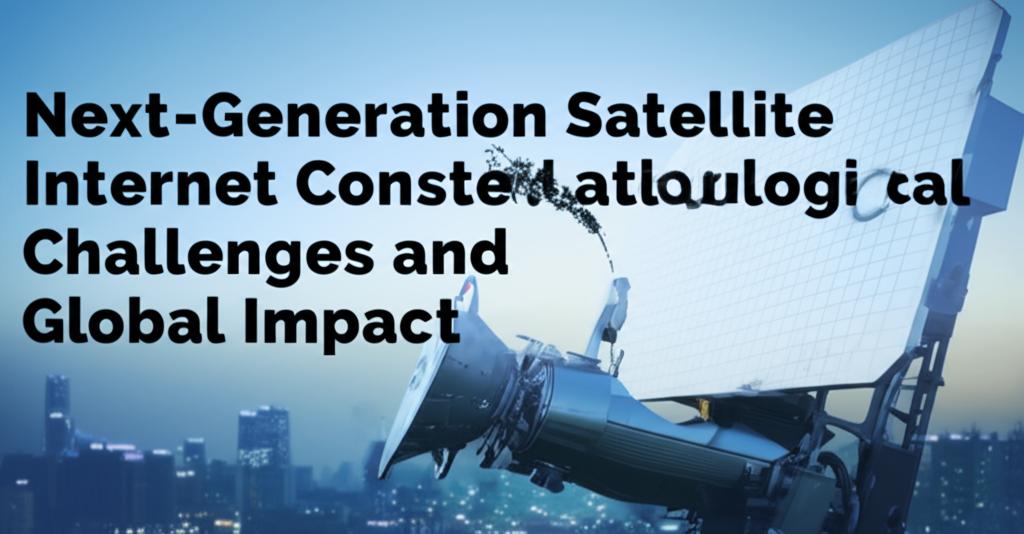The landscape of global connectivity is undergoing a significant transformation with the rapid development and deployment of next-generation satellite internet constellations. These networks, primarily operating in Low Earth Orbit (LEO), promise to deliver high-speed, low-latency internet access to virtually every corner of the globe, including remote and underserved regions. However, this technological leap is accompanied by a unique set of challenges.
Technological Challenges:- Cost Reduction: A primary hurdle is the substantial cost associated with manufacturing, launching, and maintaining large fleets of satellites, as well as producing affordable user terminals and ground equipment. Reducing these costs is crucial for long-term viability and widespread adoption.
- Latency and Speed: While LEO satellites significantly reduce latency compared to traditional geostationary (GEO) satellites, ensuring consistently high speeds and minimal delay for demanding applications like real-time gaming or remote surgery remains an ongoing challenge. Some experts suggest that speeds of 500 Mbps will be a key threshold for broader applications, particularly in fields like healthcare.
- Network Management and Optimization: Managing vast constellations of interconnected satellites, optimizing network traffic, and ensuring efficient use of orbital resources requires sophisticated AI and automation. Inter-satellite communication links (ISLs) and advanced ground station technology are critical for seamless data transfer and low latency.
- Spectrum Management: The increasing number of satellites and wireless devices intensifies competition for radio frequency bands. Effective spectrum coordination among operators and regulatory bodies is essential to prevent signal interference and maintain service quality.
- Space Debris and Orbital Congestion: With tens of thousands of new satellites planned, the risk of collisions and the proliferation of space debris pose a significant threat to the sustainability of operations in Earth's orbit. Careful management of space traffic and responsible deorbiting strategies are paramount.
- Antenna Technology: Current limitations in satellite antenna arrays, which can often only handle one user at a time, necessitate either large constellations or complex individual satellites. Innovations allowing antennas to manage multiple user signals simultaneously are crucial for reducing the required number of satellites, thus lowering costs and mitigating space debris risks.
- Integration with Terrestrial Networks: Seamless integration of satellite networks with existing terrestrial infrastructure, including 5G and future 6G networks, is vital for creating a truly ubiquitous and resilient global communications ecosystem. This includes developing hybrid satellite-terrestrial network solutions.
- Durability and Maintenance: Ensuring the longevity and reliability of satellites in the harsh space environment, along with developing capabilities for autonomous servicing and repair, are ongoing technical pursuits.
- Power and Efficiency: Future LEO satellites need to be smaller, lighter, and more energy-efficient to reduce launch costs and facilitate rapid deployment.
- Bridging the Digital Divide: Next-generation satellite internet holds the immense potential to connect unserved and underserved populations in remote, rural, and geographically challenging areas, thereby reducing global inequalities in internet access. This can unlock opportunities in education, healthcare (telemedicine), business, and economic development.
- Enhanced Global Connectivity: These constellations are set to revolutionize global connectivity by providing high-speed broadband virtually anywhere, supporting businesses, remote work, disaster recovery, and a myriad of Internet of Things (IoT) applications across various industries like maritime, aviation, agriculture, and oil and gas.
- Economic Growth and New Business Models: The satellite internet market is experiencing substantial growth, with projections indicating a market value of tens of billions of dollars in the coming years. This expansion is fostering new business models, such as satellite-as-a-service offerings.
- Geopolitical Implications: The race for satellite internet supremacy has clear geopolitical dimensions. Nations and blocs are investing heavily in their own constellations (e.g., USA's Starlink and Project Kuiper, China's planned 15,000+ satellite constellation, Europe's IRIS²) not only for commercial and civilian benefits but also for strategic and military advantages, including secure communications and Earth observation capabilities. This can lead to concerns about digital sovereignty and the potential for censorship if certain national systems become dominant.
- Advancements in Other Sectors: The technology developed for satellite internet, such as advanced communication technologies, AI-driven network management, and miniaturization, can spur innovation in other space-related and terrestrial sectors.
- Direct-to-Cell Technology: Emerging direct-to-cell (or satellite-to-mobile) services aim to provide basic mobile connectivity (messaging, voice, and data) directly to standard smartphones, virtually eliminating mobile dead zones. Companies like Starlink are already beta-testing and commercially launching such services.
- Environmental Monitoring and Disaster Management: Enhanced Earth observation capabilities through these constellations can improve environmental monitoring, climate change tracking, and disaster response efforts by providing critical data and communication links when terrestrial infrastructure is damaged or unavailable.
- Scientific Research: While beneficial, the proliferation of satellites, particularly large constellations, raises concerns among the astronomical community regarding light pollution and interference with astronomical observations. Efforts are underway to develop non-emissive satellites and mitigate these impacts.
- Rise of New Space Economies: The decreasing costs of launch and satellite manufacturing are democratizing access to space, leading to a burgeoning commercial space industry with many new actors.
Major players like SpaceX's Starlink, Amazon's Project Kuiper, OneWeb (now part of Eutelsat Group), Telesat, and Viasat are at the forefront of deploying and expanding these next-generation satellite internet constellations. Starlink, for instance, has already launched over 7,000 satellites and is available in over 100 countries, continually working on expanding its coverage and enhancing its technology, including direct-to-cell services. Project Kuiper is expected to launch its first production satellites in early 2025, aiming for over 3,200 satellites by 2029. China is also aggressively developing its own large LEO constellation.
The future points towards increasingly sophisticated, smaller, and more efficient satellites, greater integration of AI for network management, and the expansion of direct-to-device connectivity. The convergence of LEO satellite technology with 5G and the development of 6G networks is expected to create a hybrid ecosystem offering seamless, high-speed, and ubiquitous connectivity. While challenges remain, the drive to connect the unconnected and the myriad of potential applications suggest a transformative future shaped by these orbiting networks.

